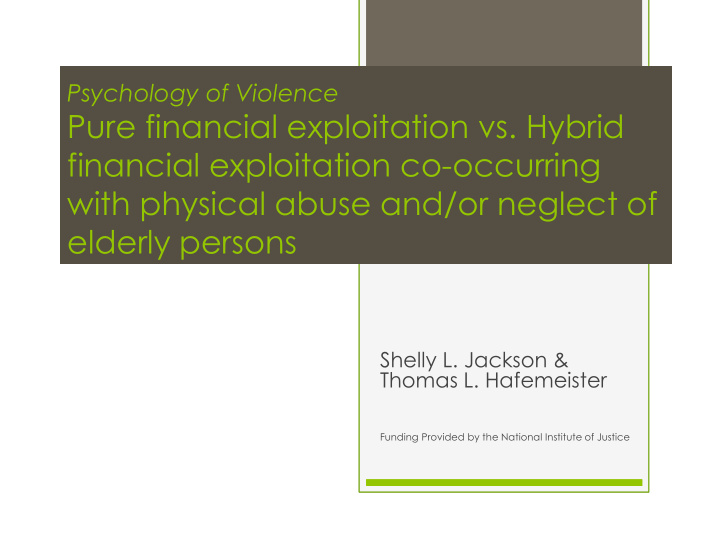



Psychology of Violence Pure financial exploitation vs. Hybrid financial exploitation co-occurring with physical abuse and/or neglect of elderly persons Shelly L. Jackson & Thomas L. Hafemeister Funding Provided by the National Institute of Justice
Acknowledgements Elderly victims APS Caseworkers APS Supervisors Virginia Department of Social Services Commissioner Conyers Gail Nardi Barbara Jenkins Todd Areson Regional Coordinators Venus Bryant
Background 2003 Elder Mistreatment Financial Exploitation Family Violence across the Lifespan 2006 proposal submitted to NIJ
How Does Financial Exploitation Differ from Other Forms of Elder Maltreatment Demographics Case characteristics & nature of the abuse Dynamics Risk factors Society’s Response Adult protective services Criminal justice response Outcomes Differences in perceptions
Pure vs. Hybrid Financial Exploitation Financial Exploitation Illegal or improper use of an elderly person’s funds, property, or assets (NCEA, 1998) Pure Experience only financial exploitation Hybrid Experience financial exploitation and physical abuse and/or neglect
Financial Exploitation Clinical vs. nationally representative samples $2.9 billion lost annually Methods of FE vary Unique set of risk factors
Literature Failed to distinguish between pure & hybrid A few studies demonstrated co-occurring financial exploitation and other abuse Whether and how they differed
Are they the same or different? Labeling theory Co-occurring risk factors
Method
Sample 42 Elderly Victims 76 years of age 74% female 81% Caucasian 56% did not graduate from HS 53% widow 54 APS Caseworkers 43 years of age 9 years as a caseworker 96% college grad or higher 31 third parties 55 years of age 44% female 64% related to victim
Design - Interviews Interview developed for the study Tell me what happened Nature of the maltreatment Victim risk factors Perpetrator risk factors Society’s response (APS and CJS) Outcomes
Procedure UVA and VDSSS IRB PI Recruits at Coordinator’s Meetings VDSS Sends Notification Letter from Commissioner Conyers PI Contacts Agency Director PI Contacts APS Supervisor Supervisor contacts caseworkers Caseworker identifies a case Caseworker contacts elder Caseworker contacts PI PI contacts elder PI interviews the caseworker PI interviews the elder PI interviews the third party
Criteria for Inclusion (Interview & ASAPS) APS Substantiated Cases FE, PA, N or HFE Over the age of 59 yrs Living in a domestic setting Disposition in the case 38 PFE and 16 HFE
Coding Nature of the abuse Content analysis of narrative 16 FE, 15 physical, 6 neglect Duration of abuse If more than once, how long? Reason for cessation of abuse Content analysis of narratives
Results
Nature of PFE $79,422 financial loss ($370 to $500,000) “Living off of” incalcuable 58% more than one form of FE 47% theft 32% fraud 0% extortion 21% improper
Nature of HFE $185,574 financial loss ($20 to $750,000) “Living off of” incalcuable 89% more than two forms of FE 56% theft 14% fraud 11% extortion 19% improper
PFE vs. HFE The use of fraud is significantly more likely in PFE than HFE
Victim Risk Factors PFE HFE Cohabitating with perpetrator Fair/poor victim health Fear the perpetrator Perpetrator as caretaker Longer duration of abuse
Perpetrator Risk Factors PFE HFE Relative Chronically unemployed Financially dependent upon victim
Perpetrator Characteristics PFE HFE Total Chronically Unemployed* 24% 38% 29% Financially Dependent** 29% 75% 42% Relative of Elderly Person*** 53% 100% 68% Serious Mental Illness 13% 31% 25% Criminal Record 40% 47% 46% Drug or Alcohol Addiction/Dependence 43% 57% 50% * P < .05, ** p < .01, *** p < .001
APS Investigation PFE HFE Contact with perpetrator Follow-up with victim Characterize these cases as difficult (trend)
Outcomes PFE HFE Change in living Continues to live arrangement alone Guardian appointed No perceived future risk New APS report filed Situation resolved Situation resolved due to removal or when APS guardianship intervened 86% did not recover anything; 7% partial (3 PFE, 1 HFE); 7% full recovery (4 PFE)
Conclusions Meaningful differences Explained by co-occurrence of abuse More deleterious when co-occurring
Summary of Differences PFE HFE Fraud Cohabitating Fair/poor health Half were related Longer duration Remain in home Fear abuser Already resolved Perpetrator as caretaker Dependent abuser Challenging cases contact abuser; follow-up Guardian Change living arrangement New APS report
Non-significant Differences Financial loss Recovery Mental illness Criminal history Substance dependence
HFE Clinical Implications Family violence model Long-term parent-child abusive relationships Abuser is key to remaining in home Love and devotion Assistance to victims Assuage fear of alternative placement Address perpetrator needs mental illness, substance abuse, unemployment Threat of criminal prosecution Multidisciplinary Teams
PFE Clinical Implications Financial White-Collar Crime model Maintain financial security & independence Obtain annual credit reports Monitor financial statements Keep valuables in locked drawers Never disclose personal information over the hone Obtain background checks Oversight
Future Research Development & progression of long-term parent-child abusive relationships Basic knowledge needed of perpetrators Testing the theoretical models proposed herein
Thank You Shelly L Jackson slj4u@virginia.edu
Recommend
More recommend